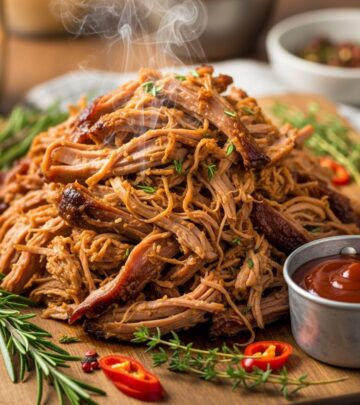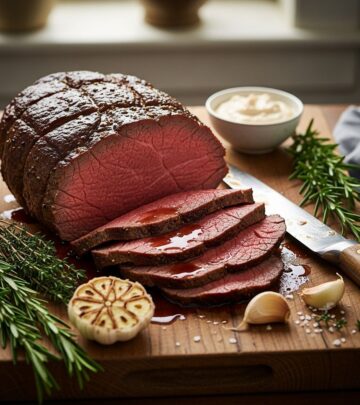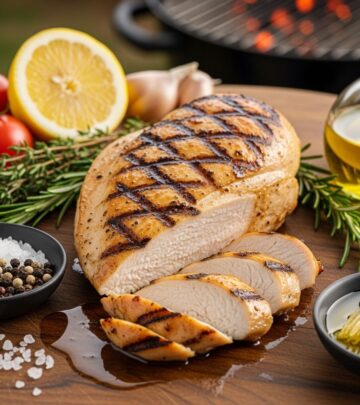The Science and Soul of BraveTart-Style Homemade Cinnamon Rolls
Enjoy melt-in-your-mouth swirls thanks to slow fermentation and yogurt-enriched dough.

If you ask any devoted baker what defines comfort, chances are they’ll paint a vivid picture of warm, gooey cinnamon rolls—aromatic swirls laced with butter and spice, crowned in cream cheese frosting. Few recipes inspire as much nostalgia and anticipation, and the BraveTart overnight cinnamon roll method has gained a passionate following for its tender crumb, complex flavor, and foolproof convenience. In this comprehensive guide, we demystify every step and technique, delivering all the secrets required to master the art of homemade cinnamon rolls for an unforgettable morning treat.
Why Make Cinnamon Rolls at Home?
Homemade cinnamon rolls elevate Sunday mornings, brunch spreads, and special occasions. Unlike store-bought alternatives, these rolls allow for full control over texture, flavor intensity, and ingredient quality. The overnight approach not only fits busy schedules but also enhances flavor via a slow, cool fermentation, leading to softer, more complexly flavored rolls the next day.
- Customization: Adjust sweetness, spice, and size for your personal preference.
- Freshness: Serve warm, pillowy rolls straight from the oven.
- Flavor Depth: Overnight proofing lets subtle notes from dairy and yeast shine.
- Rewarding Process: Baking from scratch blends therapeutic ritual and tangible reward.
Understanding the BraveTart Approach
At the heart of the BraveTart cinnamon roll recipe lies a balance between classic techniques and modern convenience. Stella Parks (aka BraveTart) carefully considers ingredient chemistry and process, ensuring reliable results. Her focus on overnight fermentation, rich dairy enrichment, and strategic handling yields a dough that is easy to work with yet results in a feather-light, aromatic roll.
What Sets This Recipe Apart?
- One-Bowl Method: Minimal fuss, less cleanup, and streamlined execution.
- Overnight Fermentation: A slow cold rise develops flavor and texture.
- Greek Yogurt & Cream Cheese: Yield an extra-tender crumb and luscious frosting.
- Balanced Spice Mix: Use of freshly grated nutmeg, quality cinnamon, and (optionally) toasted pecans for flavor depth.
- No Eggs Required: This dough relies on dairy and butter for richness, simplifying preparation and achieving a pure, plush texture.
Essential Ingredients & Their Roles
The success of cinnamon rolls depends on both the quality and function of each key ingredient. Understanding these will help you customize and troubleshoot as needed.
- All-Purpose Flour: Provides structure. Choose a moderate protein flour (like Gold Medal), not bread flour, for ideal tenderness.
- Instant Yeast: Reliable leavening and steady rise; choose fresh, reputable brands.
- Milk: Any fat percentage works, but full-fat lends extra richness and flavor.
- Greek Yogurt: Its acidity and protein help tenderness and gentle tang, mimicking sour cream’s effect.
- Butter: Melted in both dough and filling for maximum plushness and flavor.
- Sugar: Sweetens dough and feeds yeast; brown sugar in the filling adds moisture and molasses depth.
- Cinnamon & Nutmeg: Use high-quality, fresh spices—the heart of aroma and warmth.
- Cream Cheese: Essential for classic tangy-sweet icing.
- Salt & Baking Soda: Salt sharpens flavor; baking soda assists with color and gentle rise.
Step-by-Step: Making the Perfect Cinnamon Roll Dough
The BraveTart method champions a one-bowl dough—making this recipe approachable for novice bakers without sacrificing the nuanced crumb expected by pros. Here’s how the dough comes together:
- Combine Dry Ingredients:
- Flour, sugar, instant yeast, salt, and baking soda go straight into a large bowl.
- Warm & Mix Wet Ingredients:
- Gently heat milk and butter together until melted; cool slightly, then whisk in yogurt.
- Ensure the mixture is warm but not hot (about 105-115°F/41-46°C) to activate yeast while avoiding curdle or kill-off.
- Form the Dough:
- Stir the wet mixture into the dry, forming a shaggy ball. The dough will be sticky but cohesive.
- Cover and let rest 10 minutes for gluten to relax.
- Knead Gently:
- Turn dough onto a floured surface and knead for 1-2 minutes for smoothness. Avoid overworking to prevent toughness.
- The dough should be soft, slightly tacky, and resilient when poked.
Tips for Handling the Dough
- Lightly flour work surfaces to avoid sticking, but don’t incorporate too much extra flour—excess will dry the rolls.
- Knead until just smooth—minimal handling preserves a feathery texture.
Creating the Signature Filling
The true personality of cinnamon rolls comes through the filling. In this recipe, a classic blend of room-temperature butter, light brown sugar, cinnamon, and freshly grated nutmeg is spread over rolled dough, creating an intensely aromatic stripe in each swirl.
- Butter: Ensure it is soft and spreadable, but not melted, for easy distribution.
- Brown Sugar: Light brown sugar balances moisture and caramel notes.
- Cinnamon: Select a boldly aromatic cassia or Ceylon cinnamon according to your taste preference.
- Nutmeg: Freshly grated adds a floral, complexity-enhancing touch.
- Optional Toasted Nuts: Pecans or walnuts add extra crunch and richness if desired.
Assembly and Rolling Technique
- Roll dough into a large rectangle about 1/4-inch thick, working quickly to preserve airiness.
- Gently and evenly spread the spiced butter mixture all the way to the edges.
- For uniform rolls: Roll the rectangle tightly from the long side, keeping the spiral even but not compressed.
- Use unflavored dental floss or a sharp knife to slice, minimizing squishing.
- Arrange rolls in a buttered or parchment-lined baking dish, leaving a little space to rise.
The Overnight Proof
Cover the pan of assembled rolls tightly and transfer to the refrigerator. This overnight rise is the recipe’s secret weapon: it lets the yeast work slowly, deepening flavor and improving the dough’s extensibility. By morning, the rolls should appear puffier and have expanded to nearly fill the pan.
- For maximum rise, allow the chilled rolls 30-60 minutes at room temperature before baking if your kitchen is cold.
- This step means you can conveniently bake fresh cinnamon rolls for breakfast with zero morning effort.
Baking to Soft, Golden Perfection
Preheat your oven to 350°F (175°C). Bake the rolls uncovered until golden and set—about 35-40 minutes. The centers should register at least 190°F (88°C) on an instant-read thermometer, and the tops will feel springy when lightly pressed.
- Do not overbake; the rolls should retain a plush, moist crumb.
- If concerned about excessive browning, lightly tent with foil partway through baking.
The Cream Cheese Icing: Pillowy, Tangy, and Sweet
No cinnamon roll is complete without an abundant swirl of frosting. The classic cream cheese icing is made by blending softened cream cheese, vanilla, and powdered sugar until silky. Spread generously over warm rolls, allowing the frosting to partly melt and seep into every crevice.
- Let the rolls cool for 15 minutes before icing for the perfect balance of melt and structure.
- For thinner icing, add a splash of milk; for a tangier flavor, increase cream cheese slightly.
- Consider adding a pinch of salt to heighten contrast.
Variations and Baker’s Secrets
- Citrus Zest: Add finely grated orange or lemon zest to the dough or filling for brightness.
- Brown Butter: Toast the filling butter briefly for nutty depth.
- Alternative Spices: Blend in cardamom, allspice, or clove for a unique twist.
- Chocolate Swirl: Fold finely chopped dark chocolate into the filling for decadent contrast.
- Dairy-Free or Vegan: Substitute dairy ingredients with plant-based versions; results may vary in texture, but flavor can still shine.
Troubleshooting Common Issues
| Issue | Likely Cause | Solution |
|---|---|---|
| Rolls are dense/bready | Too much flour, overkneading, underproofing, or insufficient rise time | Weigh flour, knead gently, proof until doubled; try all-purpose (not bread) flour for tenderness |
| Filling leaks out | Slicing too forcefully, filling too warm, or rolling too tightly | Refrigerate log briefly before cutting; handle gently |
| Undercooked centers | Pan too crowded, oven temp inaccurate, large rolls | Use instant-read thermometer, bake until internal temp is 190°F (88°C) |
| Icing melts off completely | Frosting while rolls are piping hot | Let cool at least 10–15 minutes before icing |
Storing, Freezing, and Make-Ahead Tips
- Store baked rolls covered at room temperature for up to 2 days; rewarm gently in microwave or oven to restore softness.
- Freeze unbaked sliced rolls: Arrange in parchment-lined pan, wrap tightly, and freeze. Thaw overnight in the refrigerator before baking fresh.
- Frosted rolls can also be frozen—wrap individually for grab-and-go indulgence.
Recipe at a Glance
| Step | Description |
|---|---|
| Prep Dough | Mix and knead dough; allow quick rest |
| Shape & Fill | Roll out, spread filling, slice |
| Overnight Rise | Chill assembled rolls, covered |
| Bake | Oven bake until golden and set |
| Frost | Spread icing on warm rolls, enjoy! |
Frequently Asked Questions (FAQs)
Q: Why is overnight proofing recommended?
A: A slow, cold proof enhances flavor and produces a lighter, more tender crumb by allowing enzymes and yeasts to act slowly on the dough.
Q: Can I make the dough in advance and bake later?
A: Yes. The dough can be shaped into rolls, covered, and refrigerated up to 24 hours before baking. Alternatively, you can freeze unbaked sliced rolls and thaw before baking.
Q: How do I prevent dry cinnamon rolls?
A: Measure flour by weight for accuracy, avoid excess flour while kneading, and do not overbake. Store covered and rewarm for best texture.
Q: What’s the best way to slice the rolled dough?
A: Use unflavored dental floss or a thin, sharp knife to avoid squishing the log and ensure neat, defined swirls.
Q: Can I double the recipe?
A: Yes, this recipe doubles well. Use two pans and rotate during baking for even results.
Final Thoughts: The Joy of Sharing Homemade Cinnamon Rolls
Baking cinnamon rolls from scratch is as much about process as end result—a ritual of care, anticipation, and sharing. With the insight and mindful techniques drawn from the BraveTart-style recipe, anyone can achieve bakery-level results at home. Whether for a holiday, gathering, or a slow morning indulgence, these cinnamon rolls offer a blend of science and nostalgia, ensuring each bite is both an accomplishment and a comforting memory in the making.
References
Read full bio of medha deb












